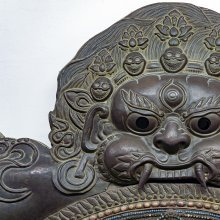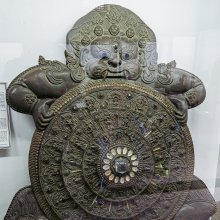Svagata, Svāgata, Svāgatā, Su-agata: 21 definitions
Introduction:
Svagata means something in Buddhism, Pali, Hinduism, Sanskrit, Marathi, Hindi. If you want to know the exact meaning, history, etymology or English translation of this term then check out the descriptions on this page. Add your comment or reference to a book if you want to contribute to this summary article.
Svagata has 21 English definitions available.
Alternative spellings of this word include Swagat.
Images (photo gallery)
Languages of India and abroad
Sanskrit dictionary
[Deutsch Wörterbuch]
Source: Cologne Digital Sanskrit Dictionaries: Böhtlingk and Roth Grosses Petersburger WörterbuchSvagata (स्वगत):—
1) adj. an der eigenen Person befindlich, ihr gehörig, eigen: tyaja saṃtāpam (svamanasastāpam die neuere Ausg.) [Harivaṃśa 6342.] na svagato yasya guṇo sti dehinaḥ [Spr. (II) 3919.] bandhavaḥ [Bhāgavatapurāṇa 10, 84, 64.] —
2) svagatam adv. = ātmagatam für sich (Etwas sagen, denken): aśrāvyaṃ khalu yadvastu tadiha svagataṃ matam [Sāhityadarpana 425.] [Śākuntala 12, 12. 22, 4.] [Vikramorvaśī 30, 8.] [Prabodhacandrodaja 22, 19. 23, 8. 24, 5. 34, 5.] [Dhūrtasamāgama 71, 8.] [Pañcatantra 27, 10. fg.] [Hitopadeśa ed. JOHNS. 1193. 2192] (cintayati).
--- OR ---
Svāgata (स्वागत):—(6. su + ā) Bildung von Ableitungen [Pāṇini’s acht Bücher 7, 3, 7.] [Vopadeva’s Grammatik 7, 3.]
1) adj. a) willkommen [Rāmāyaṇa] ed. [SCHL. II, 147, Z. 3 v. u.] [Weber’s Indische Studien 8, 376, 1.] — b) auf rechtlichem Wege eingegangen, erworben: dhanāni [Manu’s Gesetzbuch 4, 226.] —
2) m. Nomen proprium a) eines Buddha [Rgva tch’er rol pa ed. Calc. 2, 2.] [Lot. de Lassen’s Anthologie b. l. 126.] — b) eines Kaufmanns [BURNOUF,] [Intr. 198. fg.] —
3) f. ā ein best. Metrum: 4 Mal ¯ ˘ ¯ ˘ ˘ ˘ ¯ ˘ ˘ ¯ ¯ [Colebrooke 2, 160] [?(VI, 9). Śrutabodha 26. Weber’s Indische Studien 8, 375. fg. Chandomañjarī 35.] —
4) n. die Begrüssung „willkommen”, Bewillkommung [Hārāvalī 133.] [Oxforder Handschriften 103,b,23.] viprāṇāṃ svāgataṃ dharmaḥ [Mahābhārata 13, 6444.] svāgate pi kuśalaṃ na śṛṇoti [Varāhamihira’s Bṛhajjātaka S. 104, 19.] svāgatenāgnayastṛptāḥ [Spr. (II) 7334.] svāgataṃ te stu ich rufe dir „willkommen” zu [Mahābhārata 3, 2874.] [Rāmāyaṇa 1, 63, 7. 65, 18.] svāgataṃ te [Mahābhārata 3, 2985.] [Rāmāyaṇa 1, 52, 2. 2, 50, 24. 3, 75, 14.] [Suśruta 1, 1, 14.] [Kumārasaṃbhava 2, 18.] [Vikramorvaśī 11, 13] (suhṛde). [Prabodhacandrodaja 25, 5.] [Bhāgavatapurāṇa 4, 7, 36. 22, 12.] svāgataṃ tu iti proktā taiḥ [Mahābhārata 3, 2468.] maharṣe svāgatam [Rāmāyaṇa 1, 63, 19.] [Mṛcchakaṭikā 7, 1.] [Śākuntala 94, 20.] tasmai svāgataṃ vyājahāra [Meghadūta 4.] [Rājataraṅgiṇī 1, 224.] kar [Kathāsaritsāgara 7, 29. 59, 91.] vi dhā [43, 16.] vihita adj. [26, 212. 63, 74.] racita adj. [43, 79.] sasnehabahumānena svāgatenābhyanandyata (tayā) [18, 214. 24, 122.] [Bhāgavatapurāṇa 8, 18, 27.] praśna Erkundigung nach dem Wohlergehen [ŚUK.] in [Lassen’s Anthologie (III) 34, 18.] susvāgataṃ te stu [Mahābhārata 1, 3203.] [Rāmāyaṇa] [Gorresio 1, 76, 26.] am Ende eines adj. comp.: susvāgatāṃ vācamudīrayan [Rāmāyaṇa 5, 27, 35.]
Sanskrit, also spelled संस्कृतम् (saṃskṛtam), is an ancient language of India commonly seen as the grandmother of the Indo-European language family (even English!). Closely allied with Prakrit and Pali, Sanskrit is more exhaustive in both grammar and terms and has the most extensive collection of literature in the world, greatly surpassing its sister-languages Greek and Latin.
See also (Relevant definitions)
Partial matches: Sv, Gata, Agata, Shva, Cu, Shu.
Starts with: Svagata-abhivadana, Svagata-gana, Svagata-kathana, Svagata-samaroha, Svagatabhashana, Svagatakarta, Svagatam, Svagataprashna, Svagatavacana, Svagatavant.
Ends with: Agata-svagata, Agatasvagata, Apehisvagata, Asvagata, Parshvagata, Pashrnipashrvagata, Racitasvagata, Susvagata, Vishvagata.
Full-text (+31): Svagatam, Svagatabhashana, Svagataprashna, Svagama, Svagatika, Apehikata, Svagatavacana, Shodashopacara, Svagatikri, Apehisvagata, Cuvakatam, Agata, Svagata-kathana, Atmagata, Ehisvagatavadin, Cukatapetam, Cuvakatapetam, Swaagat-gaan, Sukhagata, Svagatikar.
Relevant text
Search found 36 books and stories containing Svagata, Svāgata, Svāgatā, Su-agata, Su-āgata, Sva-gata, Sv-agata, Sv-āgata, Sv-āgatā; (plurals include: Svagatas, Svāgatas, Svāgatās, agatas, āgatas, gatas, āgatās). You can also click to the full overview containing English textual excerpts. Below are direct links for the most relevant articles:
Hanuman Nataka (critical study) (by Nurima Yeasmin)
12.4. Nāṭyokti (dramatic technique) in the Hanumannāṭaka < [Chapter 4]
Hanuman-Nāṭaka, Act 9 (Summary) < [Chapter 3]
Brihad Bhagavatamrita (commentary) (by Śrī Śrīmad Bhaktivedānta Nārāyana Gosvāmī Mahārāja)
Verse 2.4.81 < [Chapter 4 - Vaikuṇṭha (the spiritual world)]
Garga Samhita (English) (by Danavir Goswami)
Verse 2.17.24 < [Chapter 17 - The Meeting of Śrī Rādhā-Kṛṣṇa]
Dasarupaka (critical study) (by Anuru Ranjan Mishra)
Part 11 - Technical Aspects of a Ḍima < [Chapter 4 - Ḍima (critical study)]
Part 13 - Technical Aspects of a Nāṭaka < [Chapter 1 - Nāṭaka (critical study)]
Part 11 - The technical aspects of a Prahasana < [Chapter 3 - Prahasana (critical study)]
Atithi or Guest Reception (study) (by Sarika. P.)
Part 9 - References to Hospitality in Mālavikāgnimitra < [Chapter 4 - Atithi-saparyā in Classical Sanskrit Literature]
Part 7 - References to Hospitality in Abhijñānaśākuntala < [Chapter 4 - Atithi-saparyā in Classical Sanskrit Literature]
Part 5 - How to appease an Atithi? < [Chapter 9 - Atithi-saparyā in Dharmaśāstra Literature]
Chandogya Upanishad (Madhva commentary) (by Srisa Chandra Vasu)



